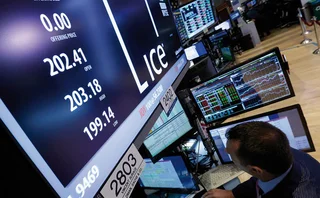Tim Bourgaize Murray: Prudent Pensions, Push-Out Pushback, and a Devastating Dismissal

For me, the best part of writing this month’s feature was researching just a little bit about the Dutch and their recent, sophisticated debate about pension fund reform.
No matter how great the advanced analytics one can throw at this growing challenge in Europe and the US alike, there is no substitute for facing it with maturity and consistency. For that, they deserve admiration.
One can only hope that this trend—perhaps enabled by greater attention to technology, or new liability-driven allocation strategies—transfers over in coming years to other geographies. After all, though they’re often ignored because they’re so far up the investment waterfall, looking after pensions is vitally important.
On the Other Hand
Speaking of stewardship, or rather lack thereof, one of my favorite pastimes of English soccer is ESPN commentator Ian Darke declaring, as if the world were ending after one side’s massive, late-game collapse, that “it’s all gone horribly wrong for them!” He’s a master of drama.
In the back of my mind, I heard him saying exactly that not once, but twice last month—not with respect to soccer, but rather decisions related to two very influential trends for the post-crisis financial markets, each of which will have at least some technology consequences in the next 12 months.
Why buy insider trading detection software when you can just invest in getting a conviction thrown out on appeal?
The first was a dismissal of an insider trading case against a pair of hedge fund managers—the first in a years-long crusade by New York Southern District US Attorney Preet Bharara—after an appeal found insufficient clarity around the age-old definitional problem of just what “inside information” is.
Two major problems here: First, the case was thrown out entirely, not just dismissed. Second: The presiding judge in the original case was also responsible for the proceedings in the much bigger SAC Capital case. That could mean it’s just a matter of time before the new standard for insider trading, itself—temporarily set, such as it was—is dead.
We’ve heard a lot about active monitoring tools around this issue in recent years, and that space, too, could be thrown into disarray as a result of all this, just as demand was presumably ramping up. After all, why buy insider trading detection software when you can just invest in getting a conviction thrown out on appeal? The greater message here isn’t a particularly progressive one.
Still Worse ...
Even more regressive, arguably, is the spending bill—the so-call “Cromnibus”—that passed the US House of Representatives with a rider that will pull back the “push-out” provision of the Dodd–Frank Act, once again making the US government an insurer of complex derivatives transactions that are profitable really for only a handful of investment banking giants.
Of course there’s much to be said here that is in no way technology-related. For one thing, a Citi lobbyist wrote the rider’s language. And one of the main arguments for removing the push-out—that somehow the entity separation makes it harder for mom-and-pop farms and other small commodities providers to hedge—is a leap of logic, at very best. But I digress.
The real tea leaf to read is that much—perhaps all—of Dodd–Frank is about to become fair game for stealthy destruction over the next two years. How much of that will come to pass, I’m not sure, but this takes me back to a trend we saw again and again at Waters USA in December. At the conference we heard in nearly every panel about figuring out ways to take advantage of regulatory mandates in alternative ways, and for other causes, than the regulation itself. Sometimes technologists just know the funding won’t be there forever, and have a second instinct for when the impetus may just vanish into thin air.
As one data management specialist said at the conference, he still remembers the joyous moment when he finally discovered Lehman Brothers’ entity identifier after a few days of endless searching in the immediate wake of the firm’s collapse. With exotic instruments once again backed by deposits, perhaps past experience—this time, at least, with the help of better data governance practices and automation—may again prove useful.
Only users who have a paid subscription or are part of a corporate subscription are able to print or copy content.
To access these options, along with all other subscription benefits, please contact info@waterstechnology.com or view our subscription options here: http://subscriptions.waterstechnology.com/subscribe
You are currently unable to print this content. Please contact info@waterstechnology.com to find out more.
You are currently unable to copy this content. Please contact info@waterstechnology.com to find out more.
Copyright Infopro Digital Limited. All rights reserved.
You may share this content using our article tools. Printing this content is for the sole use of the Authorised User (named subscriber), as outlined in our terms and conditions - https://www.infopro-insight.com/terms-conditions/insight-subscriptions/
If you would like to purchase additional rights please email info@waterstechnology.com
Copyright Infopro Digital Limited. All rights reserved.
You may share this content using our article tools. Copying this content is for the sole use of the Authorised User (named subscriber), as outlined in our terms and conditions - https://www.infopro-insight.com/terms-conditions/insight-subscriptions/
If you would like to purchase additional rights please email info@waterstechnology.com
More on Emerging Technologies
This Week: First Trust/Bloomberg/New Constructs, Cboe/Metaurus, LTX/MultiLynq, and more
A summary of the latest financial technology news.
Waters Wavelength Podcast: S&P’s CTO on AI, data, and the future of datacenters
Frank Tarsillo, CTO at S&P Global Market Intelligence, joins the podcast to discuss the firm’s approach to AI, the importance of data, and what might be in store for datacenters in the coming years.
BMO’s cloud migration strategy eases AI adoption
The Canadian bank is embracing a more digital future as its cloud strategy makes gains and it looks to both traditional machine learning and generative AI for further augmentation.
Waters Wrap: GenAI and rising tides
As banks, asset managers, and vendors ratchet up generative AI experiments and rollouts, Anthony explains why collaboration between business and tech teams is crucial.
Ice moves to meet demand for greater cloud, AI capabilities
The exchange also outlined competitive advantages behind managing its data and cloud strategy internally during its Q1 earnings call on Thursday.
FactSet looks to build on portfolio commentary with AI
Its new solution will allow users to write attribution summaries more quickly and adds to its goal of further accelerating discoverability, automation, and innovation.
How Ally found the key to GenAI at the bottom of a teacup
Risk-and-tech chemistry—plus Microsoft’s flexibility—has seen the US lender leap from experiments to execution.
Most read
- Chris Edmonds takes the reins at ICE Fixed Income and Data Services
- Waters Wavelength Podcast: S&P’s CTO on AI, data, and the future of datacenters
- BMO’s cloud migration strategy eases AI adoption







